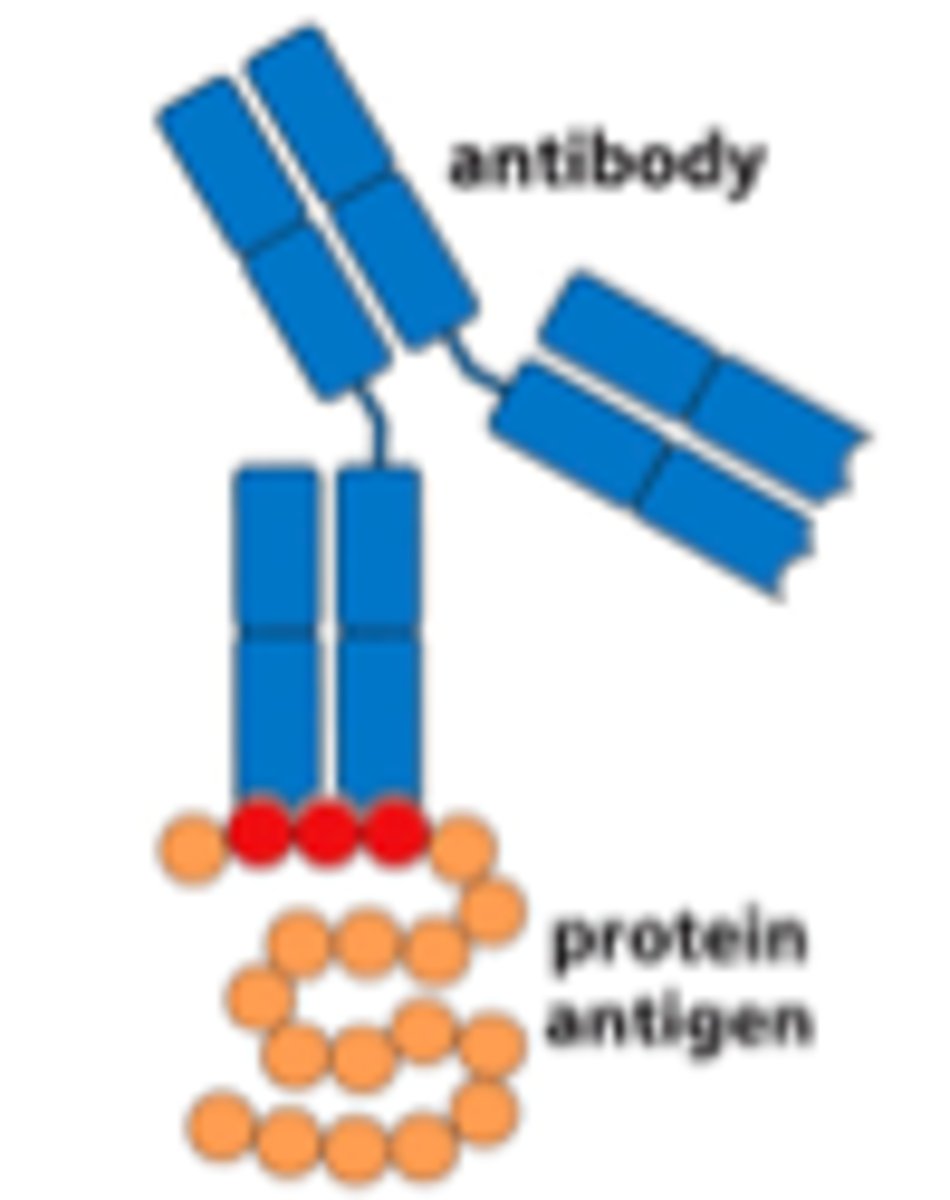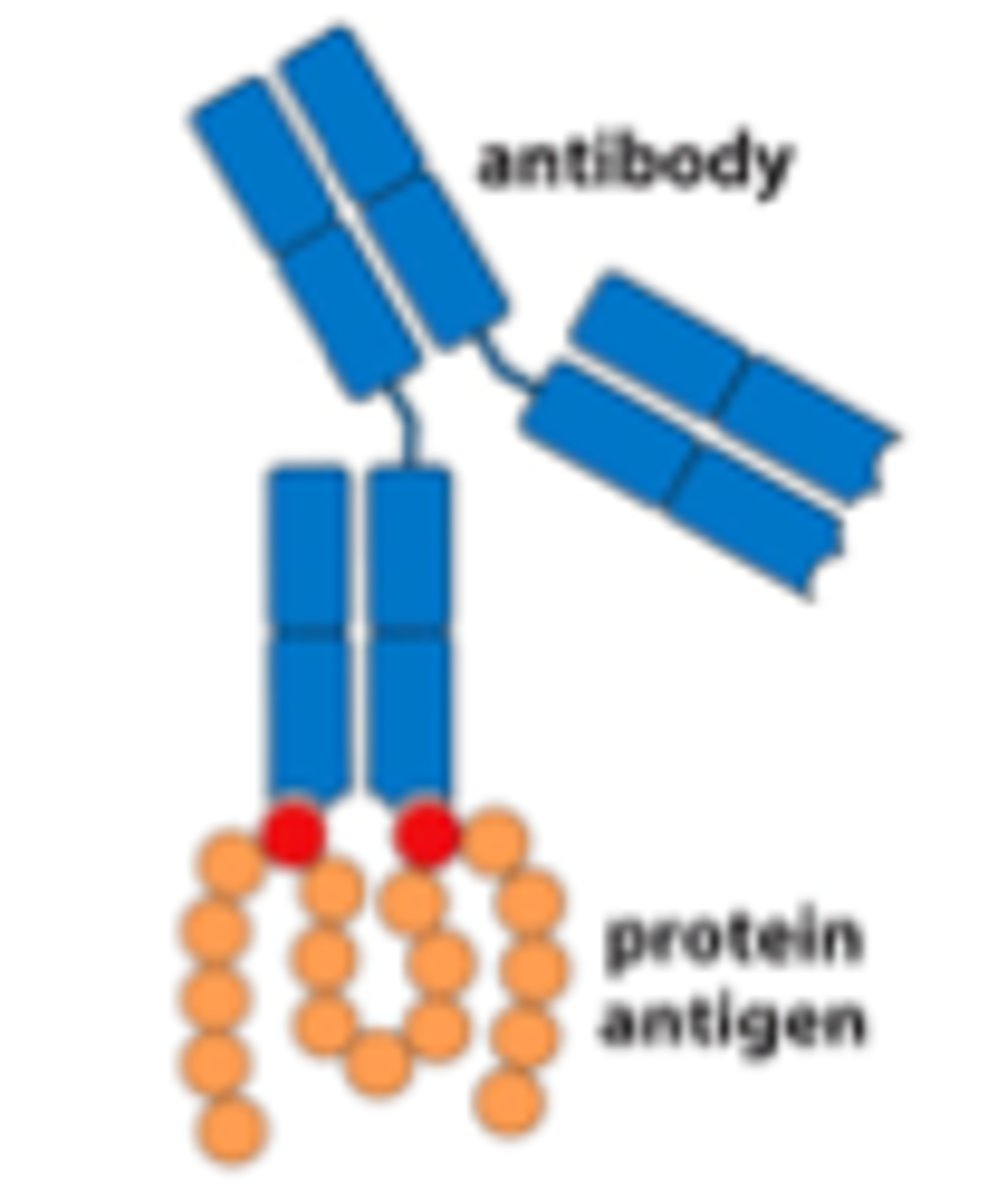Lecture 12 Immunogens & Antigens Part 2
1/38
There's no tags or description
Looks like no tags are added yet.
Name | Mastery | Learn | Test | Matching | Spaced |
|---|
No study sessions yet.
39 Terms
Mimicry
Evolved resemblance between an organism and an object or a member of another species
-Advantages for the species that mimic
-Occasionally, substances with similar epitopes and 3D structures elicit the same immune response, called cross-reactivity
Epitope
smallest unit of an antigen capable of binding with B-cell receptors, antibodies, and T-cell receptors.
Antigenic determinant (epitope)
-Approximately 5-7 aa in length (antibody)
-Approximately 8-17 aa in length (T-cell receptor)
Epitope characteristics
-May consist of a single epitope (hapten)
-May consist of many epitopes of the same specificity (polysaccharides, homopolymers)
-May consist of many epitopes of different specificity (proteins, heteropolymers)
Continuous (linear)
Sequential amino acid residues along a polypeptide chain.
-External epitopes recognized by B-cells
-Internal linear peptides presented to T-cells by APCs

Discontinuous (Conformational)
Nonsequential amino acids residues on a polypeptide chain brought together by protein folding.
-External epitopes recognized by B-cells

How do B-cells recognize antigens?
B-cells recognize and bind to free antigens in solution.
What type of epitopes do B-cells recognize?
B-cell epitopes are exposed and easily accessible, such as polysaccharide terminal side chains and hydrophilic portions on proteins.
How do T-cells recognize antigens?
T-cells recognize and bind to epitopes processed and presented by APCs through MHC class II molecules.
What type of epitopes do T-cells recognize?
T-cells recognize internal denatured linear hydrophobic areas of proteins; polysaccharides do not bind or activate T-cells.
Proteins have both
B & T-cell recognizable epitopes; Polysaccharides have only B-cell recognizable epitopes.
Antigen Binding sites
allows for the complementary fit of a specific antigen component to an antibody (Ig) or lymphocyte receptor (BCR, TCR)
-On antibodies/BCRs, the antigen binding site is sometimes called the paratope, idiotope, or idiotype.
Complementary-Determining Region (CDR)
A specific portion of the immunoglobulin that binds to the antigenic determinant (epitope) along several hypervariable regions (HV) of the molecule
Trimolecular Complex (TCR+epitope+MHC)
The smallest peptide epitope noncovalently associates with the MHC proteins of the antigen-presenting cell.
-The epitope is presented to the T-cell receptor (TCR) of a T-cell

Antigen binding
binding with BCRs, TCRs, and antibodies does not involve covalent bonds.
-Van der Waals Forces
-Electrostatic Interactions
-Hydrogen bonds
-Hydrophobic Interactions
The fit between antigen and its complementary receptor must occur over an area large enough to allow for all available interactions.
Lipids
Major class of antigen
-Rarely immunogenic
-may be regarded as haptens
-lipids become more immunogenic when conjugates to protein carries (e.g., lipoproteins)
Nucleic Acids
Major class of antigen
-Usually poorly immunogenic
-They may become immunogenic when single-stranded or when complexed with proteins (e.g., nucleoproteins)
Carbohydrates
Major class of antigen
-Mono & disaccharides are not immunogenic
-Polysaccharides can induce immunogenicity especially when associated with proteins (e.g., glycoproteins, lipopolysaccharides)
Proteins
Major class of antigens
-Virtually all proteins are immunogenic
-The greater the degree of protein complexity, the more vigorous the immune response will be
-Proportional to their size, proteins can contain multiple epitopes
Superantigens
Predominantly exotoxins produced by pathogenic bacteria (few select endotoxins)
-Not processed by the body
-Intact molecule binds to MHC class II and TCR β chain of CD4+ T-cell
-Able to activate more than 10% of the total T-cell population
superantigen exposure diseases
partially due to hyperactivation of the immune system and subsequent release of high levels of cytokines
Macromolecular antigens
contain several distinct epitopes
-Some antigens are altered without changing the immunogenic or antigenic structure of the molecule
Toxin
An antigenic poison produced or derived from microorganisms that causes disease when present at low concentration in the body
Toxoid
A nontoxic derivative of a toxin used as an immunogen in vaccines to induce antibodies capable of cross-reacting with the toxin
Cross-Reactivity
Ability of an antibody or receptor specific for one antigen to react with a second antigen; a measure of relatedness between two different antigenic substances
When two compounds immunologically cross-react
they have one or more epitopes in common
-Immune response to one of the compounds will recognize one or more of the same epitopes on the other compound and react with it
Homologous Antigen
Antigen and immunogen are the same
Heterologous Antigen
Antigen and Immunogen are different
Heterophile antigen
A cross-reacting antigen expressed by widely different species, including humans and bacteria
What is a hallmark of immunology?
Specificity
What does immunologic cross-reactivity not diminish?
Immunologic specificity
What do substances that cross-react share?
Antigenic determinants (epitopes)
Adjuvant
A substance that enhances the immune response against an immunogen
-enhances the immune response to existing immunogens but does not confer immunogenicity on haptens
-Have been used to augment immune responses for over 80 years!
Haptens
become immunogenic when covalently conjugated to a carrier
-Solitary haptens will NOT become immunogenic if mixed with adjuvants
Adjuvant mechanisms
1. Increasing the biological/immunological half-life of vaccine antigens
2. Increasing local inflammatory cytokine production
3. Improving antigen delivery, processing, and presentation by APCs
Best Adjuvants = Microbial components
Activate PRRs like Toll-like receptors (TLRs) to signal the cell to express co-stimulatory molecules and release inflammatory cytokines
Adjuvant Types
Only one has been approved by the USFDA: Aluminum hydroxide and aluminum phosphate (alum)
-Many exploit the activation properties of microbe-expressed molecules (LPS, bacterial DNA, bacterial head shock proteins)
Vaccine associated uveitis
although uncommon, has been reported as a side effect of various vaccines
-Hepatitis B is predominant, followed by HPV and Hep. A
Uveitis
a potentially vision-threatening condition involving ocular inflammation
-Accounts for 10-15% of blindness cases worldwide
-Anterior uveitis is the most common; involves the iris
-Uveitis etiology is multifactorial: autoimmune, systemic, infectious, or idiopathic